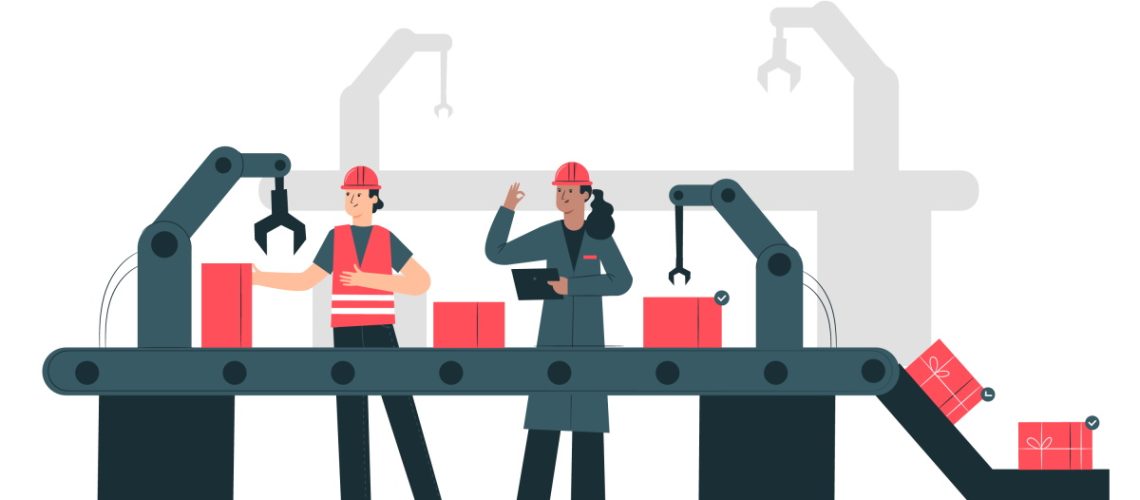Cybercrime has become a prevalent cause for concern for businesses across multiple sectors and industries. Recent statistics show that 54% of small or medium enterprises (SMEs) have been subjected to at least one cyber-attack in 2022, with many suffering such irreparable damage (financial or reputational) that they cease trading mere months later.
The cyber threat landscape is so broad and constantly evolving that pinpointing a hacker’s next target is virtually impossible. Rather, the only strategy that business leaders and decision-makers must adopt is to look at emerging data that’s currently available.
Such data, according to the IBM Security X-Force Threat Intelligence Report 2023, shows that the manufacturing industry has emerged as an area of fervent interest for many cybercriminals that lurk in the dark corners of the world wide web. In fact, for the second consecutive year, manufacturing remains the most targeted industry for cyber attackers.
Manufacturing is an industry that relies heavily on technology, system connectivity and digital awareness. As such, manufacturing companies face unique and diverse challenges when it comes to protecting their systems and data online and establishing cyber-security policies and procedures.
This article explores the reasons why the industry has emerged as prime prey for hackers, the types of threats that it faces, along with actionable steps that companies can take to avoid becoming another victim of a dangerous phishing attack.
The reasons hackers attack manufacturers
Cyber-attacks on the industrial sector have risen in recent years, meaning that manufacturers – including those that they partner with throughout the industrial and mining sectors, ranging from construction firms to driveline system integrators – must be more vigilant than ever.
But why are cyber attackers increasingly targeting manufacturers and companies that operate in the industrial sector?
- Intellectual property and confidential information
Manufacturers often develop and possess valuable intellectual property, trade secrets, and proprietary manufacturing processes. Hackers can infect a system with malware which can lock administrators out and grind production to a halt, allowing them unauthorised access to steal sensitive information which can be then used for financial or monetary gain, or to publish to the dark web.
- Supply chain vulnerabilities
The interconnected nature of the supply chains that exist throughout the world’s manufacturing industries presents numerous entry points for cybercriminals to exploit covertly. Any weak link within a network or shared system can be infiltrated if not properly secured.
Companies, particularly those in developing economies, might not have access to reliable banking or technological infrastructure to adequately secure their data, or might lack awareness of proper cyber-security best practices. As such, these firms make lucrative targets for phishing scams or malware attacks.
- Low tolerance for interruptions
Manufacturing organisations often prioritise seamless and consistent production to ensure timely deliveries to their buyers. If those production lines are disrupted by ransomware attacks, companies may be inclined to pay ransoms to avoid backlogs and bottlenecks which have a knock-on effect on their operations.
Types of phishing threats for the manufacturing industry
Phishing attacks, a prevalent form of cybercrime, pose a significant threat to the manufacturing industry. Statistically, 41% of incidents reported in the X-Force Threat Intelligence Index 2022 were believed to stem from phishing. Here are some common phishing tactics used against manufacturers.
Spear phishing
Hackers carefully research their targets within the manufacturing industry and tailor their phishing emails to appear legitimate. They impersonate trusted contacts, such as suppliers, customers, or even employees, to trick recipients into revealing sensitive information or executing malicious actions.
Whaling attacks
Also known as CEO fraud, whaling attacks specifically target high-level executives in manufacturing organisations. By posing as CEOs or other senior executives, hackers aim to manipulate employees into authorising fraudulent payments or sharing confidential information.
Watering hole attacks
Manufacturing industry-specific websites, forums, or industry portals can become watering holes for cybercriminals. Hackers compromise these platforms to distribute malware or gather login credentials, exploiting the trust that manufacturers place in industry-related online resources.
It doesn’t help that legacy equipment that exists within manufacturing facilities often remains in use for years before security patches, maintenance, and updates prove ineffective. Security breaches are, therefore, more common to take place on outdated software or devices that are outside of their manufacturers’ warranties.
How to avoid becoming the victim of a phishing attack
While the threat of phishing attacks, ransomware and other types of cybercrime remains persistent, manufacturers can take proactive measures to protect themselves and mitigate the risks. Below are five essential steps to consider taking to safeguard your data and improve your cyber-security posture.
1. Employee education and training
Implement comprehensive cyber-security awareness programmes to educate employees about phishing threats and suspicious activity that might constitute a looming or developing cyber-attack.
Train them to recognise suspicious emails, attachments, and website links. Regularly update employees about emerging phishing tactics and reinforce the importance of vigilance in all areas of the business. It’s particularly important to include relevant training on how to spot a social engineering attack.
2. Robust security measures
While fostering a culture that takes security and data protection seriously, implement strict measures and protocols across the organisation. Deploy enterprise-grade antivirus software, firewalls and internet protection programmes, as well as intrusion detection systems to spot and contain phishing attacks.
Manufacturers can also go a step further and outsource these critical IT and cyber-security operations to managed service providers, who can provide consistent 24/7 threat protection and response services, and who have the credentials, certifications and experiences to deal with threats safely and proactively.
3. Multi-Factor Authentication (MFA) and strong password policies
Implement MFA across all systems and platforms. If you set your programmes to request an additional layer of authentication for any user, such as a one-time password or biometric verification, this will significantly reduce the risk of unauthorised access even if a user’s login and password are compromised.
Alongside MFA, ensure that you implement strong password policies across your organisation, where users are encouraged to create unique passwords for each login, each consisting of a mixture of lowercase and uppercase letters, characters and numbers.
4. Regular system updates and patches
Manufacturers should prioritise regular updates and patches for their operating systems, software applications, and network infrastructure. These updates often include security patches that address vulnerabilities that could be exploited by cybercriminals. Legacy software that is no longer supported by its developers should be upgraded to scalable and evolving solutions that can be kept secure and patched.
5. Incident response and recovery plans
Develop comprehensive incident response and recovery plans tailored to your manufacturing organisation. These plans should include clear procedures and steps for identifying, containing, and mitigating the impact of phishing attacks to minimise potential damage and ensure a swift recovery. Establish a clear reporting line for all possible threats and ensure that communication remains a high priority.
As the manufacturing industry continues to adapt and embrace digital transformation, the need for robust and definitive cyber-security policies becomes all the more urgent. By understanding the reasons behind such attacks, the types of threats faced, and how to instil a culture of cyber-security, manufacturing firms can strengthen their defences and build more resilient businesses.
While the cyber threat landscape also continues to evolve at a rapid pace and shows no sign of abating, staying one step ahead of criminals where possible requires firms to be adaptable, committed and vigilant. Safeguarding your valuable operations, data, and assets by making some key decisions and investments will pay long-term dividends in the future.








